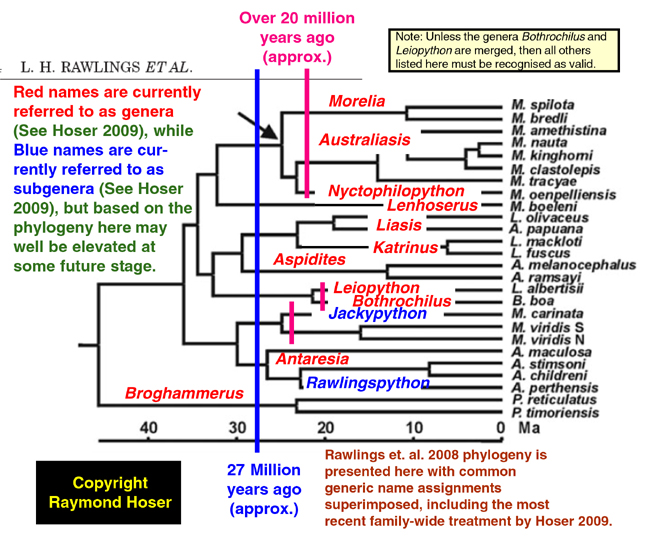Boelen's Python or Black Python - Lenhoserus boeleni (Hoser, 2000) - formerly known as Boelen's Python - Morelia boeleni or Python boeleni
Boelen's Python from island New Guinea, Boelen's Python - Lenhoserus boeleni (Hoser, 2000) - formerly Morelia boeleni or Python boeleni.
TYPE SPECIES: PYTHON BOELENI BRONGERSMA, 1953
DIAGNOSIS: A large thick-set and smooth-scaled python known only from the Island of New Guinea with one outlier population on Goodenough Island. It is presumed that these populations became split with the advent of rising temperatures and sea levels over the last 20,000 or so years. The genus is most closely related to Chondropython and Morelia.
Lenhoserus is differentiated from both other genera by its adults having a dominantly black dorsal colour in adults, interrupted only by slight and incomplete yellow bars coming up the sides from the ventral surface. None of the other two genera look like this. The differences are best seen by inspection of live specimens and/or viewing photos of the relevant species.
Lenhoserus is separated from Leiopython by a lack of scale pits on the rear of the body. McDowall (1975) also separates the genera by hemipenal morphology. Photos of Lenhoserus, Leiopython, Morelia and Chondropython can seen in O'Shea (1996). Juvenile Lenhoserus are usually reddish in general colouration and similar in appearance to Morelia.
Chondropython by contrast have a yellow or red juvenile dorsal colour, and a green or blue dorsal colour in adults, while no Morelia are as adults an almost patternless black (see next paragraph). The Morelia that are almost all black (e.g. some spilota and some cheynei) lack the semi-banded pattern on the lower sides from the belly as seen in Lenhoserus. There are also a number of other differences between the genera.
Adult Lenhoserus has a creamish belly. While Lenhoserus can be confused with Leiopython, the two are easily separated by their differing head scalation and the fact that Leiopython has a relatively longer and more gracile head. Photos of Lenhoserus in life can be found in O'Shea (1996) page 79 and Ross and Marzec (1990). The latter publication also provides photos of juvenile specimens. Lenhoserus can be definitively separated from all other pythons by genetic sequencing. Lenhoserus is restricted to mid montane forests of New Guinea (including Irian Jaya) and Goodenough Island, from altitudes of about 1,000 metres upwards, but below the treeline.
It favors humid environments and lives both on the ground and in trees.
ETYMOLOGY: Named after Len Hoser, the author's father.
The above was from the paper - A revision of the Australiasian Pythons.
(Originally published in Ophidia Review 1(1) in "Autumn" 2000 - (Publication date: October 2000), pp. 7-27).
For the text of the full paper ![]()
 Download the full paper as an MS Word document (better for printing)
Download the full paper as an MS Word document (better for printing)![]()
In 2008 Leslie Rawlings published a python phylogeny that confirmed the status of Lenhoserus as a valid genus for the Boelen's Python. Note that the divergence for the Boelen's Pythons well predates that for other well recognised python genera such as Antaresia, Aspidites diverging from Liasis and so on.
That phylogeny is republished below, with notations identifying the different named python genera.

 To download the original of this paper - with
photos exactly as it appeared in the journal Ophidia Review - as an Adobe Acrobat pdf file
To download the original of this paper - with
photos exactly as it appeared in the journal Ophidia Review - as an Adobe Acrobat pdf file